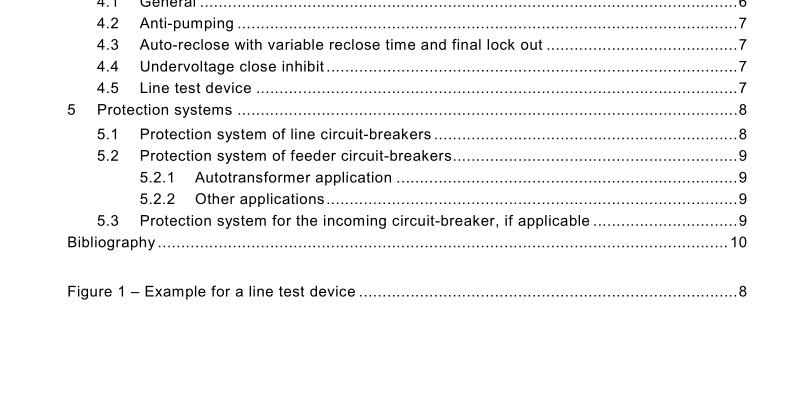IEC 62505-3-1:2009 pdf download – Railway applications – Fixed installations – Particular requirements for a.c. switchgear – Part 3-1: Measurement, control and protection devices for specific use in a.c. traction systems – Application guide
4.2Anti-pumping
This system limits the closing device to effect a single attempt while the signal to close ismaintained. lf the device fails to complete a satisfactory close operation whilst the close signalis maintained, then attempts at further reclosing (pumping) are inhibited.
An anti-pumping can be achieved in the closing control circuit in various ways,either by usingcircuit-breaker mechanism auxiliary switches or a timing relay. lt only allows a single closingpulse to the closing device,which resets when the initial closing signal is released.
The purchaser should specify the need for anti-pumping feature.
4.3Auto-reclose with variable reclose time and final lock out
Auto-reclose is only applied to line circuit-breakers and its purpose is to restore the systemvoltage to the overhead contact line automatically when there is a temporary loss of supply.
On traction systems a temporary loss of supply is not always due to permanent short circuitsand an auto-reclose system can enhance the reliability of the system.
Auto-reclose is usually associated with a timing device which gives several attempts atreclosing with varying adjustable intervals of circuit dead time.After a prescribed number ofunsuccessful recloses, then a lock out of the reclosing circuit should be instigated.The lock outrelay may then be either electrically or manually reset.
The purchaser should specify the need for this requirement and the following information:
a) number of recloses: e.g. 2 recloses then lock out;
b) reclosing time intervals: e.g. 0,3 s, followed by 180 s,followed by 180 s (see 5.17 ofIEC 62505-1);
c) lock out reset: i.e. local or remote.4.4Undervoltage close inhibit
When used and fitted to an incoming circuit-breaker on the secondary side of the tractiontransformer, the voltage signal is the voltage of the transformer.Unless the supply is availablethe circuit-breaker cannot be closed.
When fitted to a line circuit-breaker, the voltage signal is that of the busbar.Unless the busbartraction voltage is live, the line circuit-breaker cannot be closed.
The loss of the voltage signal should give an alarm or automatic tripping of all circuitsconnected thereto.This effect is achieved by undervoltage relays or other suitable voltagedetecting devices with accurate pick up and drop off voltage levels,operating on to shunt tripdevices and close inhibits.
The purchaser should specify the need for undervoltage close inhibit and the followinginformation:
a) minimum pick up voltage kV;
b) maximum drop off voltage kV.
4.5 Line test device
Line test devices are used on line circuit-breakers before closing, to prevent the line circuit- breaker closing on to a short circuit. This is achieved by inserting a resistor by means of a suitably rated switch or switch- disconnector between the switchboard busbar and the overhead contact line. The load impedance acts as a footing resistance to the inserted resistor and, by measuring the voltage between feeder and return circuit, it can allow or inhibit a close signal. An example for a line test circuit is shown in Figure 1 .
When the measured voltage is low or below a prescribed level, when there is an overload onthe line, the close is inhibited. When this voltage is above a prescribed level,then there isprobably only a standing vehicle and the close is permitted.
Line test devices may be coupled with auto-reclose schemes, thereby inhibiting a reclose if theoriginal trip was due to a fault which had not cleared itself in the dead time.
Line test devices can be by-passed if the line is already live from the line circuit-breaker at theremote end.
The purchaser should specify the need for a line test device and the following information:
a) value of the resistor and, by consequence, the current value to be chosen from 5 A to 25 A;b) whether the line test device is combined with auto-reclose.
5Protection systems
5.1 Protection system of line circuit-breakers
Line circuit-breakers are only required to trip the faults on their own section of line.
The protection relays should be selected to have characteristics and settings which willdiscriminate between heavy load caused by trains on their section of line and faults of the lineitself.
The characteristics may be selected from the following types of relays:
a) high set instantaneous overcurrent,with or without a variable time delay. Usually for close up faults;
b) impedance relay with a specified characteristic (e.g. to protect the overhead contact line);IEC 62505-3-1 pdf download.
